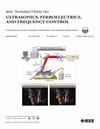Handheld Large 2-D Array With Azimuthal Planewave and Row-Multiplexed Elevation Beamforming Enabled by Local ASIC Electronics
IF 3.7
2区 工程技术
Q1 ACOUSTICS
IEEE transactions on ultrasonics, ferroelectrics, and frequency control
Pub Date : 2025-03-16
DOI:10.1109/TUFFC.2025.3570732
引用次数: 0
Abstract
Large-aperture 2-D arrays benefit from improved lateral resolution at depth, due to the dependence of beamwidth on the inverse of the aperture width, and improved contrast resolution due to electronic focusing. We have been developing modular large-aperture multirow 1024 (64 azimuth由本地ASIC电子器件实现的具有方位平面波和行复用仰角波束形成的手持大型2D阵列。
由于波束宽度依赖于孔径宽度的倒数,大孔径二维阵列得益于深度横向分辨率的提高,以及电子聚焦带来的对比度分辨率的提高。我们一直在开发模块化大孔径多排1024(64方位角× 16仰角)元件,基于定制设计和本地集成应用专用集成电路(ASIC)多路复用器件的2D阵列。所实现的手持式人体成像大阵列原型探头由多排高程多路合成孔径和方位角平面波传输组成。声阵的间距为方位角650 μm,仰角1000 μm,中心频率为2.4 MHz (FBW=88%),总有效孔径为42 mm × 16 mm。我们将大孔径阵列和多路复用ASIC,以及用于提高灵敏度的本地前置放大器设备和用于数字ASIC控制的本地FPGA连接到可配置的超声成像平台,并演示了2D正交和全3d波束形成成像。所实现的成像原型包括局部缓冲,以提高高阻抗二维阵列元件的灵敏度,并实现了低至140 mm的穿透,67 mm的实验横向/轴向分辨率为1.1 mm/0.4 mm, 8 mm圆柱形囊肿的最大实验CNR为2.1,10 mm球形囊肿的最大实验CNR为1.7。我们展示了人类志愿者肝脏的体内成像,利用密封和安全验证的手持大型2D阵列原型。初步结果对今后的临床影像学研究具有一定的指导意义。
本文章由计算机程序翻译,如有差异,请以英文原文为准。
求助全文
约1分钟内获得全文
求助全文
来源期刊
CiteScore
7.70
自引率
16.70%
发文量
583
审稿时长
4.5 months
期刊介绍:
IEEE Transactions on Ultrasonics, Ferroelectrics and Frequency Control includes the theory, technology, materials, and applications relating to: (1) the generation, transmission, and detection of ultrasonic waves and related phenomena; (2) medical ultrasound, including hyperthermia, bioeffects, tissue characterization and imaging; (3) ferroelectric, piezoelectric, and piezomagnetic materials, including crystals, polycrystalline solids, films, polymers, and composites; (4) frequency control, timing and time distribution, including crystal oscillators and other means of classical frequency control, and atomic, molecular and laser frequency control standards. Areas of interest range from fundamental studies to the design and/or applications of devices and systems.

 求助内容:
求助内容: 应助结果提醒方式:
应助结果提醒方式:


